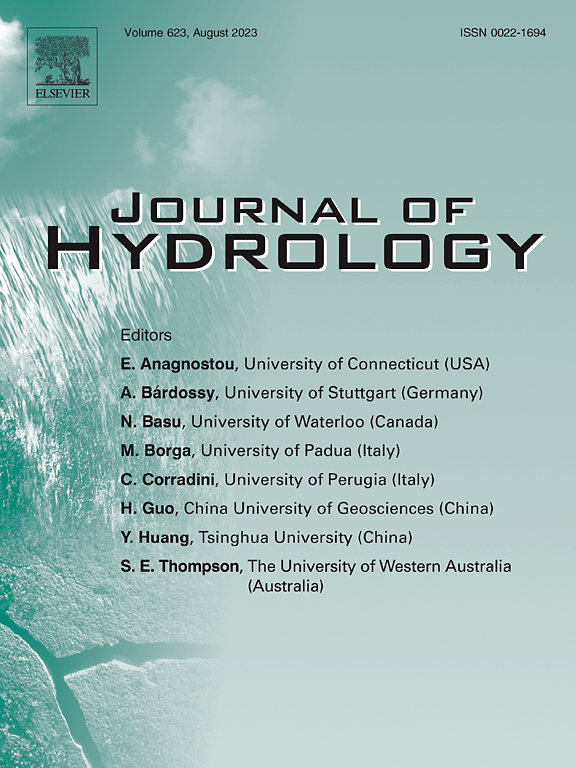Enhancing 2D hydrodynamic flood models through machine learning and urban drainage integration
IF 5.9
1区 地球科学
Q1 ENGINEERING, CIVIL
引用次数: 0
Abstract
Two-dimensional hydrodynamic flood models are commonly employed for simulating flood extent and inundation depth. However, the influence of urban drainage network (UDN) is frequently overlooked in these models, potentially compromising their accuracy. Furthermore, the expensive computational costs and longer processing times make them challenging for large-scale hydrodynamic simulation. To address these challenges, this paper develops a machine learning (ML)-driven emulator for an open-source flood model, the Two-dimensional Runoff Inundation Toolkit for Operational Needs (TRITON). A TRITON-ML Emulator (TR-Emulator) that utilizes Convolutional Long Short-Term Memory is developed to capture the spatiotemporal features of flood events based on the outputs from TRITON. We further enhance the emulator by integrating UDN parameters (TR-UDN), such as the flow capacity of drainage pipes, pipe size, and pipe length, via an ML stacking technique to improve the water surface elevation (WSE) simulation. Hurricane Harvey 2017 in Houston, TX is used as the case study. We compare WSE results from TRITON, TR-Emulator, TR-UDN, and the United States Geological Survey (USGS) observations to evaluate the performance of these models. The results indicate that the TR-Emulator effectively replicates the WSE simulated by TRITON. Additionally, TR-UDN performs well in capturing WSE patterns and peak flows, aligning more closely with USGS observations, except in areas with milder slopes where conveyance discrepancies are observed. We further test the generalizability of our ML-based models using another smaller event. This paper shows that the TR-Emulator is effective for users and engineers to emulate a 2D hydrodynamic model, and the enhanced version of the TR-Emulator, TR-UDN, can be an efficient tool for predicting WSEs during urban flooding.
通过机器学习和城市排水集成增强二维水动力洪水模型
二维水动力洪水模型通常用于模拟洪水范围和淹没深度。然而,在这些模型中,城市排水网络(UDN)的影响经常被忽视,从而可能影响其准确性。此外,昂贵的计算成本和较长的处理时间使它们对大规模流体动力学模拟具有挑战性。为了应对这些挑战,本文为开源洪水模型开发了一个机器学习(ML)驱动的模拟器,即二维径流淹没操作需求工具包(TRITON)。基于TRITON的输出,开发了一种利用卷积长短期记忆的TRITON- ml仿真器(TR-Emulator)来捕捉洪水事件的时空特征。我们进一步增强了仿真器,通过ML堆叠技术集成了UDN参数(TR-UDN),如排水管的流量、管道尺寸和管道长度,以改善水面高程(WSE)模拟。2017年德克萨斯州休斯顿的飓风哈维被用作案例研究。我们比较了TRITON、TR-Emulator、TR-UDN和美国地质调查局(USGS)观测的WSE结果,以评估这些模型的性能。结果表明,tr -模拟器可以有效地复制TRITON模拟的WSE。此外,TR-UDN在捕获WSE模式和峰值流量方面表现良好,与USGS的观测结果更接近,除了在观察到传输差异的较温和的斜坡地区。我们使用另一个较小的事件进一步测试基于ml的模型的泛化性。本文表明,TR-Emulator对于用户和工程师模拟二维水动力模型是有效的,并且TR-Emulator的增强版本TR-UDN可以成为预测城市洪水期间wse的有效工具。
本文章由计算机程序翻译,如有差异,请以英文原文为准。
求助全文
约1分钟内获得全文
求助全文
来源期刊

Journal of Hydrology
地学-地球科学综合
CiteScore
11.00
自引率
12.50%
发文量
1309
审稿时长
7.5 months
期刊介绍:
The Journal of Hydrology publishes original research papers and comprehensive reviews in all the subfields of the hydrological sciences including water based management and policy issues that impact on economics and society. These comprise, but are not limited to the physical, chemical, biogeochemical, stochastic and systems aspects of surface and groundwater hydrology, hydrometeorology and hydrogeology. Relevant topics incorporating the insights and methodologies of disciplines such as climatology, water resource systems, hydraulics, agrohydrology, geomorphology, soil science, instrumentation and remote sensing, civil and environmental engineering are included. Social science perspectives on hydrological problems such as resource and ecological economics, environmental sociology, psychology and behavioural science, management and policy analysis are also invited. Multi-and interdisciplinary analyses of hydrological problems are within scope. The science published in the Journal of Hydrology is relevant to catchment scales rather than exclusively to a local scale or site.
 求助内容:
求助内容: 应助结果提醒方式:
应助结果提醒方式:


